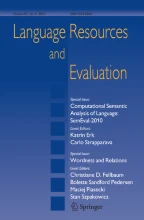Abstract
Dialectology is the study of dialects, and dialectometry is themeasurement of dialect differences, i.e. linguistic differences whosedistribution is determined primarily by geography. The earliest worksin dialectology showed that language variation is complex bothgeographically and linguistically and cannot be reduced to simplecharacterizations. There has thus always been a perceived need fortechniques which can deal with large amounts of data in a controlledmeans, i.e. computational techniques. This special issue ofComputers and the Humanities presents a range of recent work onthis topic.
Similar content being viewed by others
References
Benincà P. (ed.) (1987) Dialect Variation in the Theory of Grammar. Foris, Dordrecht.
Bloomfield L. (1933) Language. Holt, Rhinehart and Winston, New York.
Chambers J., Trudgill P. (11980, 1998) Dialectology. 2nd ed. Cambridge University Press, Cambridge.
Chomsky N. A., Halle M. (1968) The Sound Pattern of English. Harper and Row, New York.
Goebl H. (1982) Dialektometrie: Prinzipien und Methoden des Einsatzes der Numerischen Taxonomie im Bereich der Dialektgeographie. Österreichischen Akademie der Wissenschaften, Wien.
Goebl H. (1984) Dialektometrische Studien: Anhand italoromanischer, rätoromanischer und galloromanischer Sprachmaterialien aus AIS und ALF. 3 Vol. Max Niemeyer, Tübingen.
Gooskens C. (2003) How Well Can Norwegians Identify Their Dialects? Nordic Journal of Linguistics, submitted.
Heeringa W., Nerbonne J. (2002) Dialect Areas and Dialect Continua. Language Variation and Change, 13, pp. 375–398.
Kretzschmar W. A. (1995) Dialectology and Sociolinguistics: Same Coin, Different Currency. Language Sciences, 17, pp. 271–282.
Kretzschmar W. A. (1998) Analytical Procedure and Three Technical Types of Dialect. In Montgomery M. and Nunnally T. (eds.), From the Gulf States and Beyond: The Legacy of Lee Pederson and LAGS. University of Alabama Press, Tuscaloosa, pp. 167–185.
Ladefoged P. (1975) A Course in Linguistic Phonetics. Harcourt-Brace, New York.
Nerbonne J., Heeringa W., Kleiweg P. (1999) Edit Distance and Dialect Proximity. In Sankoff D. and Kruskal J. (eds.), Time Warps, String Edits and Macromolecules: The Theory and Practice of Sequence Comparison, 2nd ed. CSLI, Stanford, CA, pp. v–xv.
Nerbonne J., Heeringa W., van den Hout E., van der Kooi P., Otten S., van de Vis W. (1996) Phonetic Distance between Dutch Dialects. In Durieux G., Daelemans W., and Gillis S. (eds.), CLIN VI: Proceedings from the Sixth CLIN Meeting. Center for Dutch Language and Speech, University of Antwerpen (UIA), Antwerpen, pp. 185–202. Also available as http://www.let.rug.nl/~nerbonne/ papers/dialects.ps.
Schneider E. (1988) Qualitative vs. Quantitative Methods of Area Delimitation in Dialectology: A Comparison Based on Lexical Data from Georgia and Alabama. Journal of English Linguistics, 21, pp. 175–212.
Séguy J. (1971) La Relation entre la Distance Spatiale et la Distance Lexicale. Revue de Linguistique Romane, 35, pp. 335–357.
Tait M. (1994) North America. In Moseley C. and Asher R. (eds.), Atlas of the World's Languages. Routledge, London and New York, pp. 3–30.
Thomason S., Kaufmann T. (1988) Language Contact, Creolization, and Genetic Linguistics. University of California Press, Berkeley.
Author information
Authors and Affiliations
Rights and permissions
About this article
Cite this article
Nerbonne, J., Kretzschmar, W. Introducing Computational Techniques in Dialectometry. Computers and the Humanities 37, 245–255 (2003). https://doi.org/10.1023/A:1025064105053
Issue Date:
DOI: https://doi.org/10.1023/A:1025064105053
